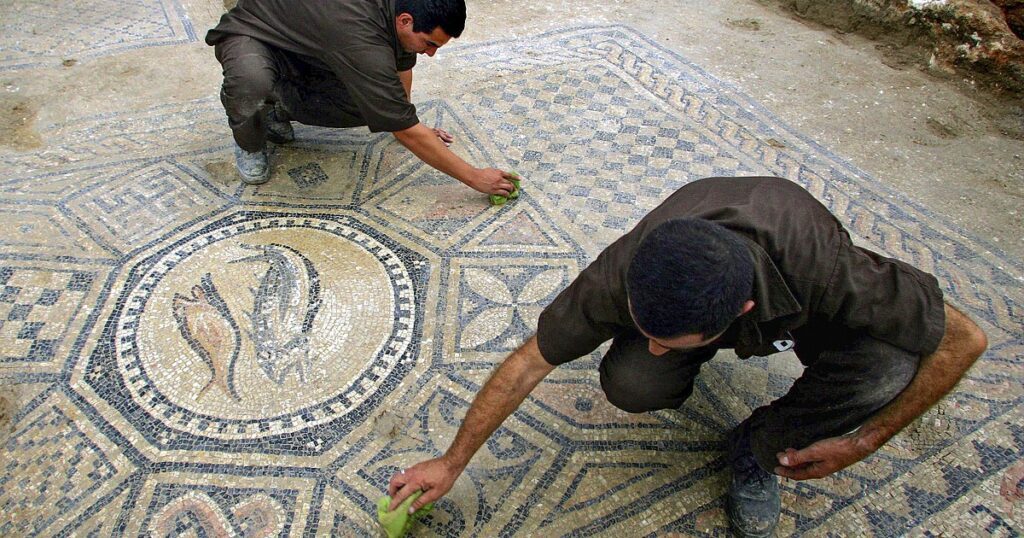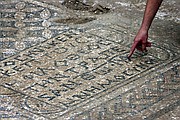TEL MEGIDDO, Israel (AP) — An ancient Christian mosaic bearing an ancient reference to Jesus as God is at the center of a controversy that has annoyed archaeologists: the centuries-old decorated floor near this believed to be the site of the prophesied Armageddon, be uprooted and loaned to a US museum that has been criticized for its past acquisition practices?
Israeli officials are considering exactly that. The proposed loan to the Museum of the Bible in Washington also underscores the deepening ties between Israel and evangelical Christians in the United States, on whom Israel now relies for political support, tourism revenue and other benefits.
The Megiddo mosaic comes from what is believed to be the world’s first Christian prayer hall, located in a Roman-era village in northern Israel. It was discovered by Israeli archaeologists in 2005 during a salvage dig conducted as part of an Israeli prison expansion project.
The prison is located at a historic crossroads, one and a half kilometers south of Tel Megiddo, at the edge of the wide, flat Jezreel Valley. The compound is surrounded by a white steel fence topped with barbed wire and is used for the detention of Palestinian security detainees.
Through a field strewn with cow dung and pottery shards, the palm-crowned site of a Bronze and Iron Age city and ancient battles is where some Christians believe a decisive battle between good and evil will take place at the end of time: Armageddon.
For some Christians, especially Evangelicals, it will be the backdrop for the long-awaited climax of the Second Coming, when divine wrath annihilates those who oppose the kingdom of God; therein lies their hopes for ultimate justice.
The Israel Antiquities Authority said it would decide on the decision in the coming weeks, after consultations with an advisory body.
“There’s a whole process that academics and archaeologists are involved in,” said IAA director Eli Eskozido. The organization said moving the mosaic from its original location was the best way to protect it from further construction in the prison.
Jeffrey Kloha, chief curator of the Museum of the Bible, said the decision on the loan would be made solely by the IAA.
The museum “would of course welcome the opportunity to educate our thousands of visitors on important historical items such as this mosaic,” he told The Associated Press by email.
Several archaeologists and scholars have voiced strong objections to the idea of removing the Megiddo mosaic from where it was found – let alone displaying it in the Museum of the Bible.
Cavan Concannon, professor of religion at the University of Southern California, said the museum acts as a “right-wing Christian nationalist biblical machine” with ties to “other institutions that promote white evangelical Christian nationalism and forms Christian Zionists”.
“I fear that this mosaic will lose its real historical context and be given an ideological context that continues to help the museum tell its story,” he said.
Others balk at the idea of moving the mosaic before the end of university studies.
“It’s really premature to move this mosaic,” said Matthew Adams, director of the Center for the Mediterranean World, a nonprofit archaeological research institute, which is helping with excavations at Tel Megiddo and the nearby Roman legionary camp of Legio.
Asked about criticism of the Washington museum’s practices, Kloha said, “Major museums and distinguished institutions committed to the preservation of history have had to deal with cultural heritage issues, particularly in recent years. »
“To be clear: The Museum of the Bible is proud to have proactively initiated extensive research and examination of items in its collections,” he added. “The museum has initiated returns, where appropriate, to countries of origin without obligation to do so and encourages other institutions to do the same.”
Based on other finds found during the excavations and the style of the letters of the inscriptions, the IAA archaeologists dated the mosaic floor to the third century – before the Roman Empire officially converted to Christianity and its followers are still persecuted. Nevertheless, one of the donors who paid to decorate the ancient place of worship was a centurion serving in the adjacent Roman legionary camp.
The mosaic bears Greek inscriptions, including an offering “To God Jesus Christ”.
Since opening in 2017, the Museum of the Bible has come under fire for its collection practices and for promoting an evangelical Christian political agenda. In 2018, she had to repatriate an ancient Mesopotamian tablet looted from Iraq and admit that several of the Dead Sea Scrolls fragments in her collection were modern forgeries. US authorities also seized thousands of clay tablets and other looted antiquities belonging to museum founder, Hobby Lobby president and evangelical Christian Steve Green, and returned them to Iraq.
The loan of mosaics would strengthen the ties between Israel and the museum. The museum sponsors two archaeological digs in Israel and has a gallery curated by the IAA. Kloha said the museum is also planning a series of lectures featuring IAA archaeologists.
Evangelical Christians, whose ranks have grown around the world, have become some of Israel’s staunchest supporters, donating large sums of money and visiting the country as tourists and pilgrims. In the United States, they also pressure congressional politicians to support Israel.
Evangelicals, who make up more than a third of the world’s 2 billion Christians, say their affinity for Israel stems from Christianity’s Jewish roots.
Some see the founding of Israel as the fulfillment of biblical prophecy, paving the way for an anticipated messianic age when Jesus will return and the Jews will either accept Christianity or die. This principle caused unease among some Israelis, but politicians nonetheless embraced evangelical support for the state.
Since its discovery, the mosaic has remained buried under the prison walls of Megiddo. But in recent years, the Israeli government has begun to put forward a multi-year plan to move the prison from its current location and develop a tourist site around the mosaic.
The archaeological site of Tel Megiddo is already a major attraction for evangelical Christians visiting the Holy Land. Busloads of pilgrims stop en route to or from the Galilee to see the ruins of a biblical city and pray at the site where they believe the apocalypse will take place.
Neither the IAA nor the museum would discuss the exact terms of the loan proposal, but Eskozido suggested something similar to a decade-long worldwide tour of a Roman mosaic found in the city of Lod, Australia. center of Israel, until Israel completed a museum to house it.
Experts remain skeptical about the uprooting of the mosaic.
“Once you take an artifact out of its archaeological context, it loses something, it loses the sense of the space and the environment in which it was first unearthed,” said Candida Moss, professor of theology at the University of Birmingham and co-author of a book on the subject. book on the Museum of the Bible.
Rafi Greenberg, professor of archeology at Tel Aviv University, said the proposal smacks of colonialism, where historically dominant powers extracted archaeological finds from settlements.
“Even though Israel never recognizes itself as a colony, it actually behaves like one, which I find strange,” he said. Greenberg said archaeological finds “should stay where they are and not be uprooted and taken overseas to another country and basically appropriated by some foreign power.”
Associated Press religious coverage receives support through the AP’s collaboration with The Conversation US, with funding from Lilly Endowment Inc. The AP is solely responsible for this content.



